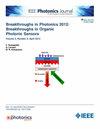Research on Single Photon Laser Communication Detection and Receiving Technology Based on Baseband Pulse Sampling
IF 2.4
4区 工程技术
Q3 ENGINEERING, ELECTRICAL & ELECTRONIC
引用次数: 0
Abstract
To realize the efficient transmission of deep space communication, single photon detection technology is used to overcome the signal attenuation and noise problems in long-distance transmission. To further achieve high-speed single-photon communication, we proposed the pulse sampling on-off keying modulation method instead of the PPM to increase the rate, and introduced the dark counting of the single-photon detector system, and a single-photon detector simulation model is set up to solve the problem of the transmission of the non-return-to-zero code in the single-photon detector. Simulation results show that the pulse sampling technique solves the transmission problem of non-return-to-zero pseudo-random sequence code in a single-photon detector, and its bit error rate is lower than 10E-4 under the condition that the non-return-to-zero code cannot allow good communication. In addition, the relationship between the dark count rate and the bit error rate of a single photon detector is analyzed. Finally, the feasibility of applying pulse sampling to single-photon detector is proved by experiments. The research results are of great significance to the study of single-photon laser communication in deep space.基于基带脉冲采样的单光子激光通信探测与接收技术研究
为了实现深空通信的高效传输,采用单光子探测技术克服了远距离传输中的信号衰减和噪声问题。为了进一步实现高速单光子通信,提出了脉冲采样开关键控调制方法来代替PPM来提高速率,并引入了单光子探测器系统的暗计数,建立了单光子探测器仿真模型来解决单光子探测器中不归零码的传输问题。仿真结果表明,脉冲采样技术解决了单光子探测器中不归零伪随机序列码的传输问题,在不归零码不能进行良好通信的情况下,其误码率低于10E-4。此外,还分析了单光子探测器的暗计数率与误码率之间的关系。最后,通过实验证明了将脉冲采样应用于单光子探测器的可行性。研究结果对深空单光子激光通信的研究具有重要意义。
本文章由计算机程序翻译,如有差异,请以英文原文为准。
求助全文
约1分钟内获得全文
求助全文
来源期刊

IEEE Photonics Journal
ENGINEERING, ELECTRICAL & ELECTRONIC-OPTICS
CiteScore
4.50
自引率
8.30%
发文量
489
审稿时长
1.4 months
期刊介绍:
Breakthroughs in the generation of light and in its control and utilization have given rise to the field of Photonics, a rapidly expanding area of science and technology with major technological and economic impact. Photonics integrates quantum electronics and optics to accelerate progress in the generation of novel photon sources and in their utilization in emerging applications at the micro and nano scales spanning from the far-infrared/THz to the x-ray region of the electromagnetic spectrum. IEEE Photonics Journal is an online-only journal dedicated to the rapid disclosure of top-quality peer-reviewed research at the forefront of all areas of photonics. Contributions addressing issues ranging from fundamental understanding to emerging technologies and applications are within the scope of the Journal. The Journal includes topics in: Photon sources from far infrared to X-rays, Photonics materials and engineered photonic structures, Integrated optics and optoelectronic, Ultrafast, attosecond, high field and short wavelength photonics, Biophotonics, including DNA photonics, Nanophotonics, Magnetophotonics, Fundamentals of light propagation and interaction; nonlinear effects, Optical data storage, Fiber optics and optical communications devices, systems, and technologies, Micro Opto Electro Mechanical Systems (MOEMS), Microwave photonics, Optical Sensors.
 求助内容:
求助内容: 应助结果提醒方式:
应助结果提醒方式:


